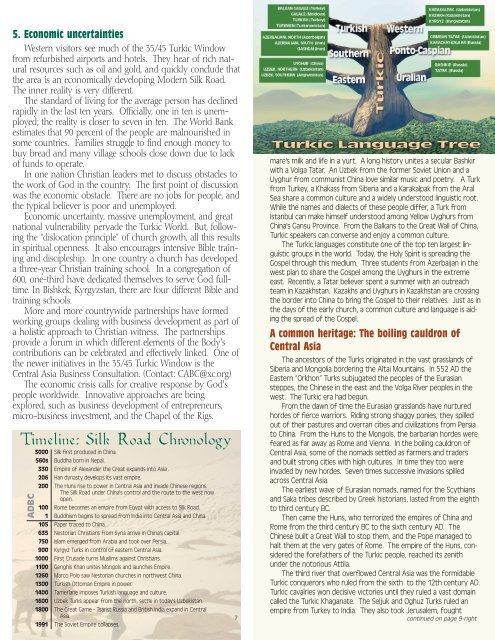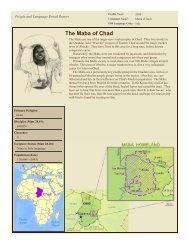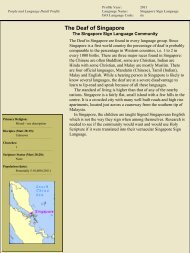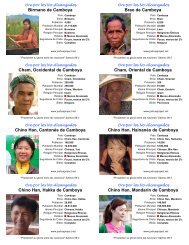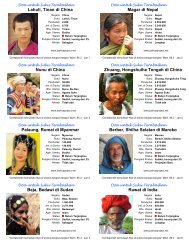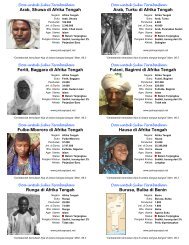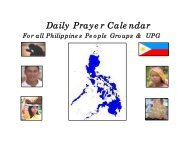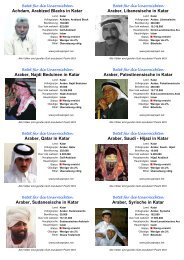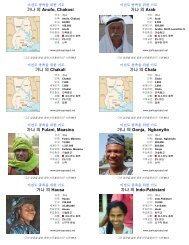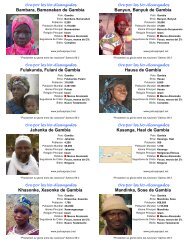AD2000 Turkic Window - Joshua Project
AD2000 Turkic Window - Joshua Project
AD2000 Turkic Window - Joshua Project
You also want an ePaper? Increase the reach of your titles
YUMPU automatically turns print PDFs into web optimized ePapers that Google loves.
5. Economic uncertainties<br />
Western visitors see much of the 35/45 <strong>Turkic</strong> <strong>Window</strong><br />
from refurbished airports and hotels. They hear of rich natural<br />
resources such as oil and gold, and quickly conclude that<br />
the area is an economically developing Modern Silk Road.<br />
The inner reality is very different.<br />
The standard of living for the average person has declined<br />
rapidly in the last ten years. Officially, one in ten is unemployed;<br />
the reality is closer to seven in ten. The World Bank<br />
estimates that 90 percent of the people are malnourished in<br />
some countries. Families struggle to find enough money to<br />
buy bread and many village schools close down due to lack<br />
of funds to operate.<br />
In one nation Christian leaders met to discuss obstacles to<br />
the work of God in the country. The first point of discussion<br />
was the economic obstacle. There are no jobs for people, and<br />
the typical believer is poor and unemployed.<br />
Economic uncertainty, massive unemployment, and great<br />
national vulnerability pervade the <strong>Turkic</strong> World. But, following<br />
the “dislocation principle” of church growth, all this results<br />
in spiritual openness. It also encourages intensive Bible training<br />
and discipleship. In one country a church has developed<br />
a three-year Christian training school. In a congregation of<br />
600, one-third have dedicated themselves to serve God fulltime.<br />
In Bishkek, Kyrgyzstan, there are four different Bible and<br />
training schools.<br />
More and more countrywide partnerships have formed<br />
working groups dealing with business development as part of<br />
a holistic approach to Christian witness. The partnerships<br />
provide a forum in which different elements of the Body's<br />
contributions can be celebrated and effectively linked. One of<br />
the newer initiatives in the 35/45 <strong>Turkic</strong> <strong>Window</strong> is the<br />
Central Asia Business Consultation. (Contact: CABC@xc.org)<br />
The economic crisis calls for creative response by God's<br />
people worldwide. Innovative approaches are being<br />
explored, such as business development of entrepreneurs,<br />
micro-business investment, and the Chapel of the Rigs.<br />
Timeline: Silk Road Chronology<br />
3000 Silk first produced in China.<br />
560s Buddha born in Nepal.<br />
330 Empire of Alexander the Great expands into Asia .<br />
206 Han dynasty develops its vast empire.<br />
200 The Huns rise to power in Central Asia and invade Chinese regions.<br />
The Silk Road under China's control and the route to the west now<br />
BC<br />
AD<br />
open.<br />
100 Rome becomes an empire from Egypt with access to Silk Road.<br />
1 Buddhism begins to spread from India into Central Asia and China.<br />
105 Paper traced to China.<br />
635 Nestorian Christians from Syria arrive in China's capital.<br />
750 Islam emerged from Arabia and took over Persia.<br />
900 Kyrgyz Turks in control of eastern Central Asia.<br />
1000 First Crusade turns Muslims against Christians.<br />
1100 Genghis Khan unites Mongols and launches Empire.<br />
1260 Marco Polo saw Nestorian churches in northwest China.<br />
1300 Turkish Ottoman Empire in power.<br />
1400 Tamerlane imposes Turkish language and culture.<br />
1600 Uzbek Turks appear from the north, settle in today's Uzbekistan.<br />
1800 The Great Game - Tsarist Russia and British India expand in Central<br />
Asia.<br />
1991 The Soviet Empire collapses.<br />
7<br />
mare's milk and life in a yurt. A long history unites a secular Bashkir<br />
with a Volga Tatar. An Uzbek from the former Soviet Union and a<br />
Uyghur from communist China love similar music and poetry. A Turk<br />
from Turkey, a Khakass from Siberia and a Karakalpak from the Aral<br />
Sea share a common culture and a widely understood linguistic root.<br />
While the names and dialects of these people differ, a Turk from<br />
Istanbul can make himself understood among Yellow Uyghurs from<br />
China's Gansu Province. From the Balkans to the Great Wall of China,<br />
<strong>Turkic</strong> speakers can converse and enjoy a common culture.<br />
The <strong>Turkic</strong> languages constitute one of the top ten largest linguistic<br />
groups in the world. Today, the Holy Spirit is spreading the<br />
Gospel through this medium. Three students from Azerbaijan in the<br />
west plan to share the Gospel among the Uyghurs in the extreme<br />
east. Recently, a Tatar believer spent a summer with an outreach<br />
team in Kazakhstan. Kazakhs and Uyghurs in Kazakhstan are crossing<br />
the border into China to bring the Gospel to their relatives. Just as in<br />
the days of the early church, a common culture and language is aiding<br />
the spread of the Gospel.<br />
A common heritage: The boiling cauldron of<br />
Central Asia<br />
The ancestors of the Turks originated in the vast grasslands of<br />
Siberia and Mongolia bordering the Altai Mountains. In 552 AD the<br />
Eastern “Orkhon” Turks subjugated the peoples of the Eurasian<br />
steppes, the Chinese in the east and the Volga River peoples in the<br />
west. The <strong>Turkic</strong> era had begun.<br />
From the dawn of time the Eurasian grasslands have nurtured<br />
hordes of fierce warriors. Riding strong shaggy ponies, they spilled<br />
out of their pastures and overran cities and civilizations from Persia<br />
to China. From the Huns to the Mongols, the barbarian hordes were<br />
feared as far away as Rome and Vienna. In the boiling cauldron of<br />
Central Asia, some of the nomads settled as farmers and traders<br />
and built strong cities with high cultures. In time they too were<br />
invaded by new hordes. Seven times successive invasions spilled<br />
across Central Asia.<br />
The earliest wave of Eurasian nomads, named for the Scythians<br />
and Saka tribes described by Greek historians, lasted from the eighth<br />
to third century BC.<br />
Then came the Huns, who terrorized the empires of China and<br />
Rome from the third century BC to the sixth century AD. The<br />
Chinese built a Great Wall to stop them, and the Pope managed to<br />
halt them at the very gates of Rome. The empire of the Huns, considered<br />
the forefathers of the <strong>Turkic</strong> people, reached its zenith<br />
under the notorious Attila.<br />
The third river that overflowed Central Asia was the formidable<br />
<strong>Turkic</strong> conquerors who ruled from the sixth to the 12th century AD.<br />
<strong>Turkic</strong> cavalries won decisive victories until they ruled a vast domain<br />
called the <strong>Turkic</strong> Khaganate. The Seljuk and Oghuz Turks ruled an<br />
empire from Turkey to India. They also took Jerusalem, fought<br />
continued on page 9-right


